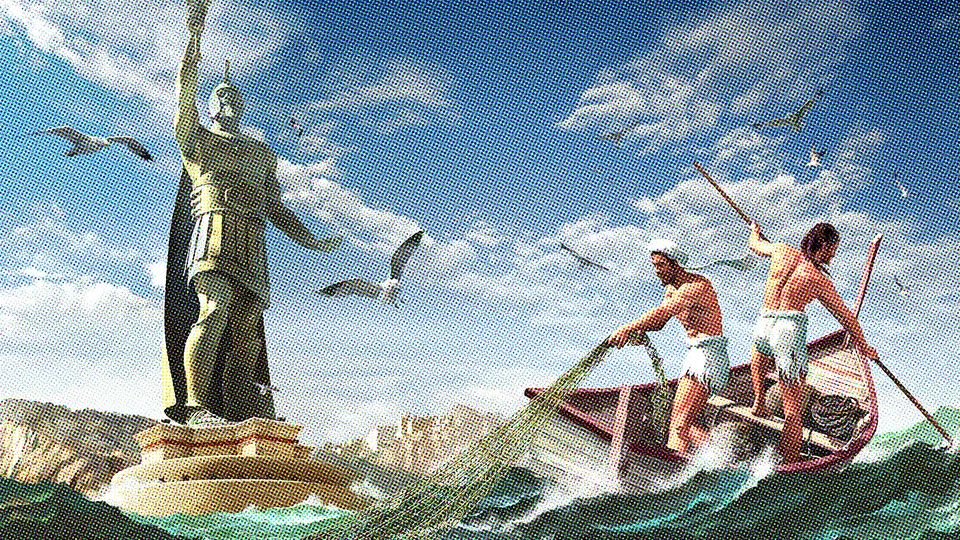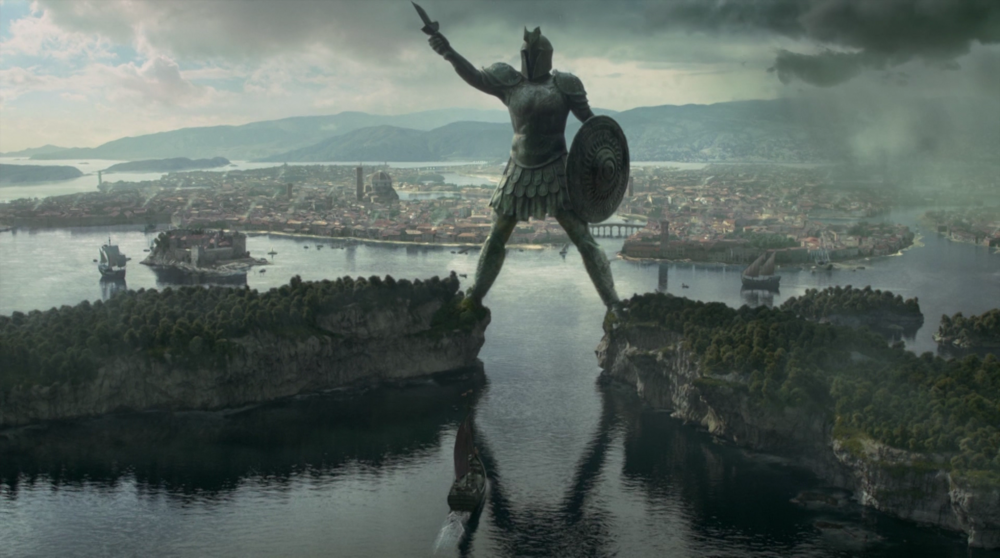Oh Wonder: On the Colossus of Rhodes

Lately I’ve been asking (bewildered) friends how many of the Seven Wonders of the Ancient World they can name. Here is a list of their collective answers: the pyramids and that’s it. Specifically, the answer they’re looking for is the Great Pyramid of Giza, which is not just the oldest of the seven by far, it’s the only one still in existence. Here’s the lesser-known six: the Hanging Gardens of Babylon, Temple of Arthmis at Ephesus, Statue of Zeus at Olympia, Mausoleum at Halicarnassus, Colossus of Rhodes, and Lighthouse of Alexandria.
All are really interesting in their own way. For example, it’s disputed whether the Hanging Gardens of Babylon actually, y’know, existed! But the one I fuck with the most has got to be the Colossus of Rhodes. So much so that I’m here to tell you everything I’ve learned about it and everything I think about it.
Towering over the harbor entrance to the city of Rhodes, on the Greek island (once independent) of the same name, the Colossus of Rhodes was an approximately 100-foot bronze statue of the sun god Helios. Completed in 280 BC by sculptor Chares of Lindos, it stood for but a millisecond in the mushroom cloud of history—54 years to be exact—before an earthquake brought it crashing down to Earth.
Sitting south east of mainland Greece, just 18 kilometers off Turkey, Rhodes has historically been receptive to outside influence. It actually sided with Persia against Alexander the Great, only to flip once it looked like Alexander was getting the better of Persia. The great conqueror, of course, defeated the Persians in 331 BC.
Alexander died without a succession plan, leading to three of his generals—Ptolemy, Seleucus, and Antigonus—dividing the kingdom among themselves. Rhodes formed strong commercial and cultural ties with the Ptolemies in Alexandria. To break that alliance, Antigonus directed his son, Demetrius, to attack Rhodes in 305 BC. After a one-year siege, and with a relief force of ships sent by Ptolemy arriving, Demetrius gave up on the idea and signed a peace agreement. To celebrate holding out, the Rhodians sold most of the abandoned siege equipment and used the money to build a giant statue of Helios, their patron god.

Construction was orchestrated by Chares, though according to legend, he was so ashamed by a flaw in the statue, he committed suicide before work was completed.
An abandoned siege tower was used for scaffolding around the lower levels during construction. Builders also piled mounds of dirt around the sides of the statue to aid the build. Finally, after 12 years of work, the Colossus of Rhodes was completed in 280 BC.
The harbor overseen by the statue was a vital link for trade. I sometimes imagine what it was like for sailors arriving into Rhodes and seeing such a behemoth appearing on the horizon. Were they tingling with anticipation? Were some unaware of its existence and taken by surprise by the vision of this behemoth? Unfortunately, all too few got to witness the Colossus in all its glory. When the earthquake hit, the statue snapped at the knees and fell over onto the land. The pharaoh Ptolemy III offered to pay for the reconstruction of the statue, but worried that they had offended Helios, the Rhodians declined.
That wasn’t the end of the statue’s life, however. The remains lay on the ground for over 800 years. Even in a twisted pile, the ruins were so impressive that many traveled to see them. Roman author Pliny the Elder is said to have remarked that few people could wrap their arms around the fallen thumb and that each of its fingers was larger than most statues.
Cut to 654 AD, when Islamic Umayyad forces under Muawiyah I captured Rhodes. It’s said that the remains of the statue were sold to a traveling salesman from Edessa, Mesopotamia, who had them scrapped and the bronze transported to his home on the backs of nine hundred camels.
Thus ended the lifespan of the Colossus of Rhodes. But then the legend began. Because for all the chronicles of its existence, we don’t know exactly where the statue stood or, believe it or not, what it looked like.

Look up illustrations and they tend to show the Colossus of Rhodes with one foot on either side of the harbour mouth, allowing ships to pass through its legs. This is undeniably the most glamorous vision of the monument—unfortunately, experts agree it was impossible. The Colossus, they say, could not have been built with its legs apart without collapsing under its own weight. It would also have needed to be significantly larger than accounts claim.
There are other practical reasons to discount this myth. If the Colossus had straddled the harbour, it would have been effectively closed during the entirety of the construction—impossible given its importance to Rhodes’ economy. Plus, the fallen statue would have blocked the corridor, rather than remaining visible on land for the next eight centuries.
No, more likely the Colossus of Rhodes stood somewhere near the harbor entrance in a legs-together posture. One theory is that it actually stood on a hill overlooking the port area.
Other details cribbed from various accounts include the presence of a crown, though little clothing. The base is believed to have been made of marble and the statue was also said to hold a flaming torch reaching to the sky. It’s most commonly said to have been 108 feet tall, though I’ve seen everything from 98.4 to 125 feet being suggested.
For generations, the statue appeared in poetry and literature. Into the 20th century, it lived on in pop culture. There is the 1961 movie The Colossus of Rhodes, directed by the great Sergio Leone. It was the Italian’s first directing credit and one of only nine movies he helmed, albeit with few of his classic touches (it’s his only movie without an Ennio Morricone score, for example.) Look, it’s not The Good, the Bad and the Ugly, but as a sword-and-sandal flick, it’s perfectly acceptable rainy-afternoon fair.
The plot is entirely invention: Athenian soldier Darios (Rory Calhoun) arrives for some rest and relaxation in Rhodes just in time for the unveiling of the Colossus, but gets caught up in multiple schemes to overthrow the king.
The statue, too, deviates from reality. Here, it is dedicated to Apollo, not Helios. It’s considerably taller that the real Colossus. Of course, it straddles each side of the harbor entrance like the popular depiction. It’s also built as a military defense weapon. Holding a bowl of fire at chest level with elbows raised outward, it has the ability to drop flames on any ship that passes through, while it’s head can open up and rain down molten lead on any threat (really).
The plot also demands that inside the statue is more luxuriant that Master P’s house in the early 2000s. There’s a web of staircases, leading up to a room where you can view outside through the statues eyes and exit via its ears— at one point Darios climbs out and fights enemy soldiers on the Colossus’s shoulders—plus a drawbridge-style door in the center chest and a chain system that controls sliding doors to a dungeon prison.
You will also find various fictional proxies. You may remember Game of Thrones and the Titan of Braavos, a 400-foot fortress in the shape of a massive statue of a warrior that straddles the harbor entrance to the city.

But the Colossus’s influence is most greatly felt in its most famous analogue: the Statue of Liberty. The monument is almost identical in size of the Colossus. It holds up a torch and wears a crown. And if there was any doubt of the Rhodian icon’s influence on it, you can read “The New Colossus,” an 1883 sonnet by Emma Lazarus written on a cast bronze plaque and mounted inside the pedestal of the statue in 1903. The most famous extract of the piece is, “Give me your tired, your poor, your huddled masses yearning to breathe free,” which alludes to the hopes of the immigrants arriving in the United States in the 1880s through New York. But its opening lines are as follows:
Not like the brazen giant of Greek fame,
With conquering limbs astride from land to land;
So there you go. The Colossus of Rhodes’s offspring lives on Liberty Island. I’d imagine for arriving immigrants, the experience of seeing her from sea once mirrored the splendour of viewing the Colossus. But I can’t help but imagine Chares of Lindos’ creation as being so much cooler. The gaps in our knowledge can be filled with whatever our imagination creates.
For a long time there’s been talk of building a new Colossus on Rhodes on the island, but much constantly hearing plans for a Titanic II, I wonder if it’ll ever actually happen. Then again, with this generation, everything has to be a remake, amirite?
I’ll be there within 12 months of its opening.
Thanks for sticking with me to the end of this one. Paid subs help fund these (admittedly bizarre) meditations, so please consider taking one out. Plus, you immediately get access to the sub-only stuff, including The 20 Best Irish Rap Songs of 2021 and the 100 Great Rap Songs of the 2000s series. I believe people are saying these are must-reads.
I also have a profile of the New York rapper MIKE in Crack Magazine this week, so take a look at that too.